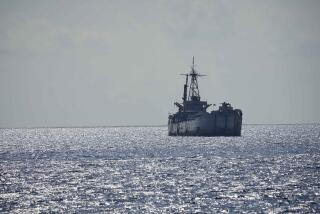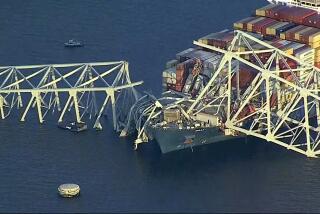Bodies Washing Ashore in Philippine Disaster : Many Aboard Were Believed Trapped as Ships Sank; Child Reported Found Clinging to Log
- Share via
MANILA — Bodies began washing up Tuesday on the shores of a Philippine island, testimony to what may be one of the largest peacetime death tolls in maritime history.
The navy announced today that 141 bodies have been recovered along the coast of Mindoro island. At least 20 charred bodies were found Tuesday at or near the fishing village of Herrera, and a navy spokesman said today that bodies were being found at two other locations on the island.
More than 1,500 Filipinos, many of them headed for Christmas vacations in Manila, were believed drowned or burned to death late Sunday night in the collision of a three-deck, inter-island ferry and a small oil tanker. Twenty-six survivors were pulled from the water by a passing cargo vessel shortly after the collision, but searchers Monday could find no trace of the accident--no wreckage, no bodies--eliminating all but a thin reed of hope for further survivors.
There was an unconfirmed report of one more survivor Tuesday. Antonio Babijes, director of the Philippine Rescue Coordination Center, told United Press International that a radio operator in the governor’s office in Oriental Mindoro had reported that fishermen found a 4- or 5-year-old boy clinging to a log along the shore in the village of Pinamalayan, about 10 miles from the scene of the sinkings.
Reportedly Helped by Father
Jose Dino, a government communications operator in Pinamalayan, told the Associated Press by radio-telephone that the boy was conscious and had told rescuers his father put him on the piece of timber after the collision.
The coast guard could not confirm the report, however, and the island has no telephone links with Manila.
“It is possible that there may be more survivors since commercial ships responded immediately to the SOS call of the (ferry) Dona Paz,” coast guard Commandant Carlito Cunanan said late Monday. “Other survivors may have been picked up and taken to other ports.”
But Tuesday passed without word from any other ships. The only known survivors were brought to Manila by another inter-island vessel, the Don Claudio, which was first to the scene, arriving while both the ferry and the tanker were afloat and burning. The skipper of the Don Claudio remained in the area for several hours, sweeping the sea with searchlights and taking aboard only the living for fear that stopping to retrieve bodies might be costly for survivors.
From dawn Monday until the appearance of the bodies on the beach of Mindoro Island--described in a Reuters news service report from the scene--no trace was found of the disaster.
“There is not even a piece of debris,” said Nelson Gonzales, a spokesman for the Rescue Coordination Center.
As the survivors spoke with reporters at Manila hospitals Monday, telling their stories of panic and flames, the coast guard formed an investigation board. But so far no evidence has been disclosed on the cause of the collision in the Tablas Strait between Mindoro and Marinduque islands, about 110 miles south of Manila.
The sea was calm and the night clear, according to all accounts. Many survivors say the Dona Paz was overloaded with passengers sleeping on the decks and in the passageways, when the collision occurred about 10 p.m. One report put the number at 1,490 paid passengers and 53 crewmen, plus uncounted children who boarded the ferry free. That plus the 13-member crew of the tanker would place the total at 1,556, or 1,530 lives lost and 26 survivors.
Passenger Manifest Lost
The Dona Paz’s passenger manifest went down with the vessel, and the exact total of victims may never be known. The coast guard has said the ferry was capable of carrying 2,200 passengers, but some survivors have estimated the number at almost twice as many. Philippine inter-island ferries are notoriously overcrowded, especially during holiday periods.
The crowded conditions aboard the ferry led to the high loss of life but had no evident bearing on the accident.
The Tablas Strait, an east-west corridor through the center of the Philippine island group, is heavily traveled by inter-island traffic. In 1980, just 40 miles from the site of Sunday’s disaster, the ferry Don Juan collided with the tanker Tacloban City, killing more than 1,000 people.
Search teams this time were frustrated by rain both Monday and Tuesday and by the absence of wreckage on the surface of the 1,800-foot-deep water. As the search resumed Tuesday, Carlos Go, executive vice president of the Sulpicio Lines, owners of the Dona Paz, expressed disbelief that no more survivors had been found.
Gonzales, the rescue center spokesman, said a last-minute decision caused withdrawal of aircraft from Tuesday’s search.
“The aerial search was temporarily suspended because nothing was found,” he said.
Naval authorities speculated that most of the passengers were trapped in the burning ship and carried down with it as it sank. The fire apparently broke out on the Victor, which was carrying more than 8,000 barrels of oil, and spread quickly to the ferry.
President Corazon Aquino declared the disaster “a national tragedy of harrowing proportions,” her spokesman said.
More to Read
Sign up for Essential California
The most important California stories and recommendations in your inbox every morning.
You may occasionally receive promotional content from the Los Angeles Times.













